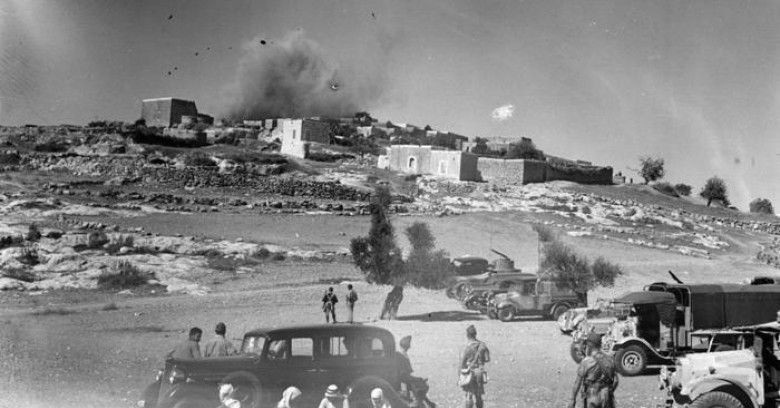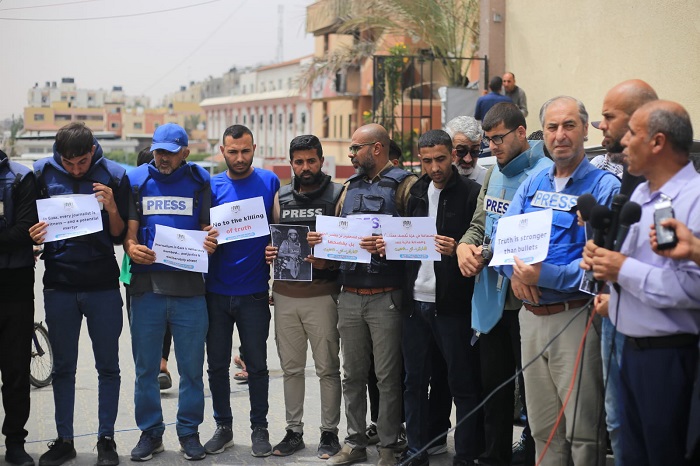By: Jameel Dababat
JERUSALEM, June 20, 2018 (WAFA) – With a mixture between using modern technology and basic traditions, Wassim Razouq tattooed Helen Lamark’s arm, and once the ink penetrated her skin, the Holy Cross, one of the many religious signs that many tourists seek to get in the Holy Land, finally appeared.
Lamark arrived in Jerusalem with a group of French tourists, and just like any other tourist that comes to such a holy city that has a great history, she made sure to get an inerasable sign on her body, as she told WAFA correspondent.
This holy tattoo is the only one many visitors crave to have on their body, something that they have been doing for hundreds of years, before leaving Jerusalem.
The Razouq family arrived in Jerusalem 500 years ago along with other Egyptian pilgrims, and quickly adjusted to the city’s traditions that also matched the family’s Coptic values.
Two hundred years before its arrival in the holy city, the location of the tomb of Jesus Christ, the Razouq family crafted painting of the holy tattoo in Egypt.
In a quiet place in the Christian Quarter of the Old City of Jerusalem, Wassim Razouq recounts the story of the 700-year history of the sacred ink that the family still prints on the body of Christian believers who arrive daily in Jerusalem.
When Razouq finished the tattoo on Lamark’s arm, he said that it’s the sign of coming to Jerusalem, it is a visa printed on the skin, while Lamark, still with the blue ink on her wrist, said that this is how she will keep her memory of Jerusalem forever, as her friend who accompanied her to the tattoo shop agreed.
In the past five centuries, the Razouq family inherited the profession of tattooing; but as Wassim says today, it is not the only profession.
"My grandfather was a carpenter and a tattoo artist, and my aunt was a teacher and also worked in tattooing,” he said. “The tattoo craft was always present in the Razouq family job list.”
He said that his family is proud of the fact that they painted part of the history of the Holy City, but in a unique style.
"We painted it all over the world. I tattooed Americans, and they became a bit speechless when I told them that the tattoos I was drawing on their bodies were 500 years old,” he said. “Older than America itself."
The Cross of Jerusalem appears to be one of the signs of the city. It is a large cross with four small crosses attached to each side of it. In the Old City of Jerusalem, this sign can be seen engraved on stones or on olive wood sold in souvenir shops. It is actually engraved on a stone next to the Razouq’s shop.
Just a few meters away from the Razouq tattoo shop on St. George‘s Road and about 100 meters from the Church of the Holy Sepulcher, the cross appears at the entrance of the Terra Sancta Girls‘ School and Saint Joseph’s School.
The Razouq tattoo shop is full of history, and that includes an ancient seal dating back hundreds of years that was used by the early tattoo artists in the family in drawing tattoos on Christian pilgrims of Jerusalem. It also includes many stories that carry other meanings in addition to the religious meanings.
An Armenian man tells the story of two tattoos that belong to two different worlds: the world of the grandfather, Yacoub, and the world of the grandson, Wassim.
In 1958, when the Armenian man was 5 years old, he visited the holy city of Jerusalem and his mother took him to the shop of Razouq and put him in her lap as he was tattooed that year by Yacoub, Wassim’s grandfather. Today, 60 years later, the man returns to the city with a new history.
Razouq himself recounts the story of the Coptic Christian who first came from Egypt in 1965 and had that year tattooed on his arm. He returned again in 2000 and 2007 and every year since 2011 and got every year he was here tattooed on his arm.
"We give him a visa… a visa that is not going to be erased by time," said Razouq.
Because Razouq‘s shop is a little hidden behind a main road that leads to Jaffa Gate, one of the main gates of the Old City, it is clearly a quiet area because it is away from the noise of passers-by. There is no sound to be heard in the shop except for the faint sound of modern electric tattooing machine.
But this calm is exactly the opposite of a question that’s now being heavily circulated in major international newspapers and media that are analyzing a historic visit by a British prince to Jerusalem.
Will Prince William, the eldest son of Prince Charles and the late Princess Diana, give his hand to Razouq to put a tattoo of the Cross of Jerusalem as his ancestors did with Razouq’s ancestors?
The British Royal Palace has announced the planned visit of the Duke of Cambridge to Jordan, Israel and Palestine that will start on the 24th of this month, and Jerusalem’s Old City will be part of his program.
But will St. George‘s Road, where Razouq’s shop is located, be on Prince William‘s map?
"If he goes there, he may come through this road," said Razouq, pointing his hand to the road leading to the Church of the Holy Sepulcher, the most visited place by pilgrims, politicians and tourists.
The historical visits of British princes to the Holy Land began with Prince Albert Edward in 1862 and were followed by the visits of his two sons Prince Albert Victor and George V some 20 years later.
In those royal visits, Prince William‘s ancestors tattooed their arms with five crucifixes and three crowns, according to the British Israel Research and Communication Center.
"These were tattooed by my grandfathers here in Old Jerusalem," said Razouq.
The center, known as BICOM, said on its website that Prince William may follow in the footsteps of three of his predecessors who visited Jerusalem as royal princes to choose a traditional tattoo as the cross of a crusader on his arm.
An Egyptian Christian from the Razouq family in the ancient city of Jerusalem tattooed the crucifixion of the traditional Crusader knight on the arms of King Edward VII, King George V, Prince Albert and Duke of Clarence.
"If William comes here, even if suddenly and without previous arrangement, I would devote the time to him like any visitor to Jerusalem and engrave his tattoo,” said Razouq. “This would be a beautiful thing ... history would be repeating itself.”
There are many reasons for visits by internationals to the Razouq shop, including what Razouq sees in the Christian history in the city, and what some see as an eternal memory on their body, as seen by Lamark.
Another reason is to obtain one of the ancient drawings that Egyptian Copts used to tattoo on their forearms, such as the Nile Mermaid Tattoo, which is what the family of Razouq was famous for during its stay in Egypt and took later with it to Jerusalem.
The family of Razouq has put the mark of Jerusalem on the bodies of thousands of people, which is why Wassim says that the relationship between the history of his family and the history of the Holy City is a charming relationship as every tattoo comes with a fascinating history: “It’s not a history of a family that makes food or tobacco. It’s the history of Jerusalem, the Cross of Jerusalem. Visitors to the holy city are given a certificate of their visit to the city.”
In May 1938, the last of the emperors of Ethiopia, Haile Selassie, arrived in Jerusalem and of course getting a tattoo from the Razouq family was one of the things he did during his stay in the city.
"My grandfather Yacoub tattooed him,” Wassim said as he pointed to a photograph of his grandfather hanging on the wall, along with closets containing tattoo kits at the time.
Because the profession is inherited, Wassim is now proud that his 15-year-old son Nizar, who spends some of his time in the shop, has now started to tattoo the visitors too.
The tattoo patterns of the old molds vary, but the process of getting a tattoo is now less painful and faster. For example, Lamark‘s tattoo took less than five minutes, two of which she spent in obvious fear on her face, but when she finished she felt extremely thrilled after getting the Cross tattoo.
The heavy shades from the walls of the stone houses in Jerusalem Old City on the space available in front of the shop turn this small area outside Razouq’s shop a location for tourists to listen to a narration of the history of this place while they wait to get a tattoo.
While inside the shop, Razouq and his customers can hear the historical narration that comes from outside. Some enter individually or in pairs to get the tattoo of St. George on his horse, or a tattoo of Aramaic words, which are used on a small scale, or look for a replica of an old wooden mold for a tattoo representing the resurrection of Jesus Christ.
It is impossible to predict the shape of tattoos requested by pilgrims or tourists. But if the Crown Prince of the United Kingdom wants a tattoo on his arm from Razouq, it will be the cross and the crowns tattooed on his ancestors’ arms a century ago by the Razouq ink.
Razouq says he is ready for that.
K.T./M.K.











